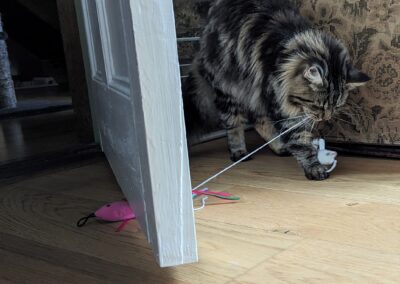Bringing a new cat into your home can be a wonderful experience, but it can be a challenge if you already have one or more cats. It’s important to plan carefully to ensure a smooth transition for all involved. Introduce a new cat slowly to minimize stress and prevent tension and conflict. This process can take anywhere from a few days to a few months, and sometimes longer. Do not move to the next step until each cat is comfortable with the current step.
Step 1: Adoption Decisions for a New Arrival
- Take your time and avoid spur-of-the-moment decisions.

- Understand their needs. Will your home meet the needs of another cat? Ensure you have enough space and resources, including a quiet ‘transition room’ for the new cat.
- Ensure that all cats, both resident and new, have had recent veterinary check-ups and are in good health. Consider their age, playfulness, social habits, adaptability, and if they can deal with the introduction process and group living to ensure they will be able to integrate together.
- Should you add one cat or two? If you are considering two, opting for cats who are already bonded—like siblings—can lead to a smoother transition; however, you must consider the needs of your resident cat(s).
- If you are unsure whether your cats will get along, foster-to-adopt programs can be a great way to try out the relationship before fully committing.
|
Step 2: Home Preparation
- Place additional resources (see above) throughout the home to prevent competition and tension. Not having sufficient, visually separated resources is the most common cause of tension between cats.
- Set up a safe transition room for the new cat with food, water, a litter box, perches, hiding spots, a soft bed, scratching surfaces, and toys.
Step 3: Plug in Feline Synthetic Pheromone Diffusers
- To minimize intercat tension, plug in one diffuser in the main living area and another in the transition room 24–48 hours before the new cat arrives.
Step 4: Identify Favorite Activities or Treats for Each Cat
- Treats and favorite activities can be used as training rewards. Be sure to identify what every cat prefers.
The Introduction Process
| If any step does not go well and the cats appear distressed, stop immediately and go back one or more steps. Move at a pace comfortable for your cats and only proceed when they are relaxed with the current step. We cannot force cats to be friends, but a slow, calm, well-prepared introduction process can help minimize tension and conflict. |
Introduce a new cat slowly to minimize stress and prevent tension and conflict. This can take a few days to a few months, and sometimes longer. Do not move to the next step until each cat is comfortable with the current step.
Step 5: Initial Isolation
- Bring the new cat into the transition room in a covered carrier to prevent cats from seeing each other. Let the cat choose when to come out, explore, and become comfortable.
Step 6: Scent Introduction
- Swap bedding or soft items between the new cat and resident cat(s) to mix their scents without direct contact.
- Repeat this step daily until the cats appear comfortable with the new scent.
Step 7: Scent Transfer
- If the cats are comfortable with each other’s scent after a few days, rub a cloth that contains the scent from one cat over the other cat’s cheeks and chin, and in between the eyes and ears.
- Place the scented cloths where both the new cat and the resident cat(s) can smell them.
Step 8: Playtime Interaction
- If cats are not stressed with scent transferring, encourage them to play on each side of a closed door.
- Make a dumbbell-like toy by tying two cat toys together with strong string, and put one toy on each side of the closed door. The cats should not be able to see each other.
- Keep play sessions short (5–20 minutes) and stop before the cats lose interest.
- If one cat hisses or growls at the door, do not discipline them. Instead, distance the cats before allowing them to try again by creating a neutral space or barrier in front of the transition room door (e.g., shoji screen, boxes, or chairs).
Step 9: Supervised Exploration
- When the new cat is settled in the transition room and all cats are comfortable with the previous steps, put the resident cat(s) in a different and favored room with the door closed.
- Let the new cat explore the communal areas briefly without the resident cat(s) in the room.
- After a short period, return the new cat to the transition room and let the resident cat(s) have access to the communal areas again.
Step 10: Visual Access
- Allow short sessions where the cats can see each other through a screen, glass door, extra tall cat gate, or similar see-through barrier. You can also use partially covered cat carriers if the cats are comfortable with their carrier and have only had positive experiences in it.
- Pay attention to each cat’s body language and vocalization. If they are uncomfortable, go back to Step 8 for a few more days before trying again.
Step 11: Supervised Physical Proximity
- When the cats are comfortable seeing each other, try supervised sessions with harnesses and leashes held by adults.
- Watch for signs of fear-anxiety or frustration, and be ready to step in if needed. Do not interact with cats who are hissing, growling, flicking their tail, or showing other signs of stress as cats can redirect their frustration onto nearby people or objects. Have a towel, pillow, or cardboard ready to block their view of each other if tension rises, and when they are calmer, separate the cats and go back to Step 8.
- Have toys scattered around the room and treats handy to distract and reward the cats.
- Start with short sessions and gradually increase the time the cats spend together and reduce supervision as they get used to each other, until they can coexist without tension.
If any step does not go well and the cats appear distressed, stop immediately and go back one or more steps. Move at a pace comfortable for your cats and only proceed when they are relaxed with the current step. We cannot force cats to be friends, but a slow, calm, well-prepared introduction process can help minimize tension and conflict.
Recognizing and Managing Tension
Understanding the signs of tension and knowing how to respond can help maintain a peaceful household. The most common signs are subtle.
- Subtle Signs of Tension: Staring, blocking, tail twitching, walking away, hiding, stalking, and tufts of hair in odd locations.
- Blatant Signs of Tension: Chasing, fleeing, hissing, growling, swatting, house-soiling, overgrooming, screaming, physical fighting, and jumping onto another cat.
Proactive Strategies:
- Continuous Monitoring: Observe cat-to-cat interactions and be ready to intervene if you see signs of tension.
- Environmental Adjustments: Regularly update and enhance the home environment to meet all cats’ needs.
- Preventive Measures: Plan ahead and introduce new cats gradually, ensuring each cat’s individual needs are met.
If tension persists, contact your veterinarian. In more challenging cases, consultation with a board-certified veterinary behaviorist is needed.
| For a detailed guide with strategies and solutions for introducing a new cat, download our Step-by-Step Guide here. |



